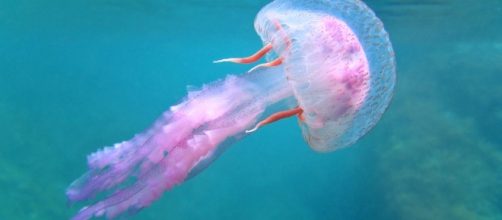The Ocean.
It's a common saying that human beings have explored more of outer space than they have of our oceans. We have discovered about 5% of our oceans and honestly, we know really little about the kinds of Animals that live there. Here are a couple of interesting examples that I came across.
Some animals that live in the deep and how they survive.
Squid
Deep sea squid are among a number of predators that have adapted themselves to surviving in the deep where food is not always at hand or easy to see. With its two eyes, one facing up and another down the squid can be able to with the eye facing up see prey that camouflages itself against the sky and the other smaller one looks onto prey that camouflages itself using bioluminescence.
National Oceanic and Atmospheric Administration scientists captured rare footage of a deep sea squid. The whiplash squid which is about one to two meters long, the sighting was a one in a million event stated experts. This observation was made on September 19th, 2015, the scientists said it emits a bright light, which they believe is used to blind prey, measure distance or signal courtship.
Copepod
These may just be the most abundant animal species on the planet, living in virtually all marine and freshwater habitats. They are very small in size .6 cm and mostly eat diatoms (between 11,000 and 373,000 diatoms in 24 hours!) other phytoplankton and also themselves are a source of nourishment to other animals, including filter feeders, larval fishes and other drifters.
They just may be the most important food source of animal plankton there is.
Sea Cucumbers
Sea Cucumbers are invertebrates sized between 0.75 inches to 6.5 ft. Echinoderms like sea urchin and starfish, there are approximately 1,250 different known species of sea cucumbers. Some of its habitats are in shallow waters, others on the ocean deep and some the ocean floor, some even partially buried.
They are omnivores with an average lifetime of between five to ten years. They are considered to be the oceans earthworms as one of their dietary items are waste materials which they then break down into smaller pieces which then become fodder for bacteria, completing the recycling process. Cucumbers eggs and young larvae are prey for fish and other marine animals.
Humans, especially in Asia, also diet on them and some species are farmed as delicacies.
6-Gill Shark
The 6-gill shark, also known as the cow shark and the mud shark is the largest shark that feeds on prey other than plankton. It’s related to today’s dogfish and Greenland shark, although much more closely related to relatives who date back to over 200 million years ago, it is much closer related species found in fossils only. These rarely see sharks preferred habitat is over 2,000 feet deep, with its size ranging from 12 to 18 feet. It got its name by having an extra gill while other sharks have five gills, it also has only one dorsal fin located at the back of its body near the tail. They are a large variety of shark which can grow to a length of 16 feet with the females generally being larger than the males.
They also feed on rays, and other marine animals, coming out to hunt in the shallow waters usually at night. They live mainly solitary lives so in-depth knowledge about how they live isn't available, although apart from the great white they have the highest distribution for sharks. They are also classified as endangered animals. 6-gill sharks are ovoviviparous meaning the eggs are carried within the mother's body until they hatch. It’s immediate survival of the fittest for the young pups since they have been known to eat the unfertilized eggs and sometimes each other. The number of pups born range from 22 to 108 born at any given time, suggesting that there is a very high mortality rate among the pups and not many survive till maturity, with the ones that do living up to 80 years in the wild.
Pompeii Worms
Known as the most heat tolerant among other higher life forms, after beating the Sahara Desert ant which survives at temperatures of over 131F, this worms behind sits at waters as high as 171F, while its gill covered head rests at a cooler 71F. These worms live in paper-like tube colonies attached to hydrothermal vent chimneys.
As they are located in the deep, and cannot utilise the sun to survive, upon discovery they became the first living organisms known to man that didn't depend on the sun to survive. So how do they survive? They use the sulphides from the vents. The worms have specialised bacteria that are able to derive energy from the sulphides pouring from the vents. These microbes and bacteria are at the foot of the food chain of which hundreds of species depend on. After the vents discovery in 1979, new species have been described every 10 days.

